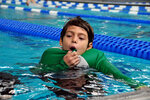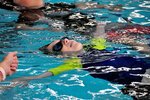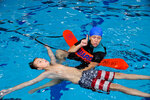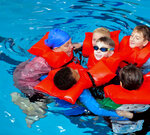Clear, 86°
Wind: mph,





Some Oak Hill Elementary School fifth-grade students got to spend a day at the pool instead of the classroom on October 10.
The students of teachers Adrienne Appel and Heather Birrane spent the day at the Annapolis-based Arundel Olympic Swim Center participating in a water safety program.
The course, which started in 1979 and is dubbed Water Ready with Drownproofing program, is something each fifth-grade student in the Anne Arundel County Public Schools system — more than 6,500 — participates in. Organizers of the program say there are other aquatic safety courses around, but Anne Arundel’s program is unique in Maryland and the U.S.
“They’re around so much open water and pools in this area, I think it’s important to know water safety,” said Appel, noting that it’s a good age to stress it as children gain more independence as they transition to middle school.
This is not a swim to one end of the pool and back type course. Certified aquatic safety instructors, many of whom have taught in county classrooms, spearhead lessons for each class of students focused not just on personal water safety, but they also train on personal flotation devices, safe rescues of others, cold water survival techniques, hypothermia and ice safety.
During the program, students learn water safety skills in the pool, which are augmented through lessons in the classroom that are aligned with the language arts and physical education curriculum.
Along with the Arundel Olympic Swim Center, the Millersville-based Arlington Echo Outdoor Education Center hosts students during certain months.
“A lot of people die from this, and it’s important to know survival skills when you’re out on the water,” said student Rachel Crockett.
The Anne Arundel County Public Schools Water Ready with Drownproofing program is part of the Environmental Literacy and Outdoor Education Office, where Melanie Parker serves as the coordinator.
Parker said data they have collected shows that 30% of fifth-grade students in the county are not water competent and more than half of the county’s elementary schools have more than 40% of their students who cannot swim, or they are not confident and can’t go in water over their head. She also cited a Centers for Disease Control and Prevention report showing that drowning is the second-leading cause of unintentional death for students under 14 years old. A student’s water competency is measured by seeing if the child can lift their face out of the water in a depth that is over their head as well as ensuring they can swim 25 yards without stopping or touching the bottom.
Instructors replicate scenarios as they teach, such as telling the kids they are trying to save energy because they don’t know when the boat will arrive. Another instructor was detailing what part of a wave to dive into and one was reciting the f-l-o-a-t, bubbles and breathe technique for survival.
Oak Hill student Suri Garrido said the rescue portion was her favorite of the program.
“I had a lot of fun,” Suri said. “It’s like you’re actually a lifeguard.”
Students donned different attire depending on the lesson — flotation devices, full clothing, a mass of devices where students huddled together in the water to simulate how they would stay warm in an emergency — and not only was the import of protecting oneself in and around the water stressed, but also the safety of those around.
Crain Clark is a student who didn’t know how to do much in the water going into the course.
“Now I know different ways of swimming,” Crain said. “I feel a lot safer after what we did.”
It’s not just a course for those new to the water.
Fifth-grader Harper Bensky enjoys surfing on Florida beaches and said she benefited from the program.
“You have to swim in different kinds of ways and stuff,” Harper said. “I learned new ways to swim.”
Nyla Inserro enjoyed learning about rescue because she can help others with that knowledge; Trevor Calish said floating on his back was a highlight, adding a reminder of fifth-grade priorities.
“Not a lot of people can go in a pool during a school day,” Trevor said.
Amy Greif, a teacher specialist for Anne Arundel County Public Schools and co-director of the water safety program, along with county school program specialist Heather McCarthy, quizzed the students on what they had learned at the end and had some words for the fifth-graders as they prepared to wrap up their trip to the pool.
“You now have some skills and strategies to be safe around the water,” said Greif, who wishes more counties across the nation would implement programs like theirs but said resources and logistics can make it difficult in some areas.
There was one last exchange with the visitors.
“Do your part,” Greif said, pausing briefly before the response — in unison — from every student, educator and parent volunteer filled the room.
“Be water smart.”
Comments
No comments on this item Please log in to comment by clicking here